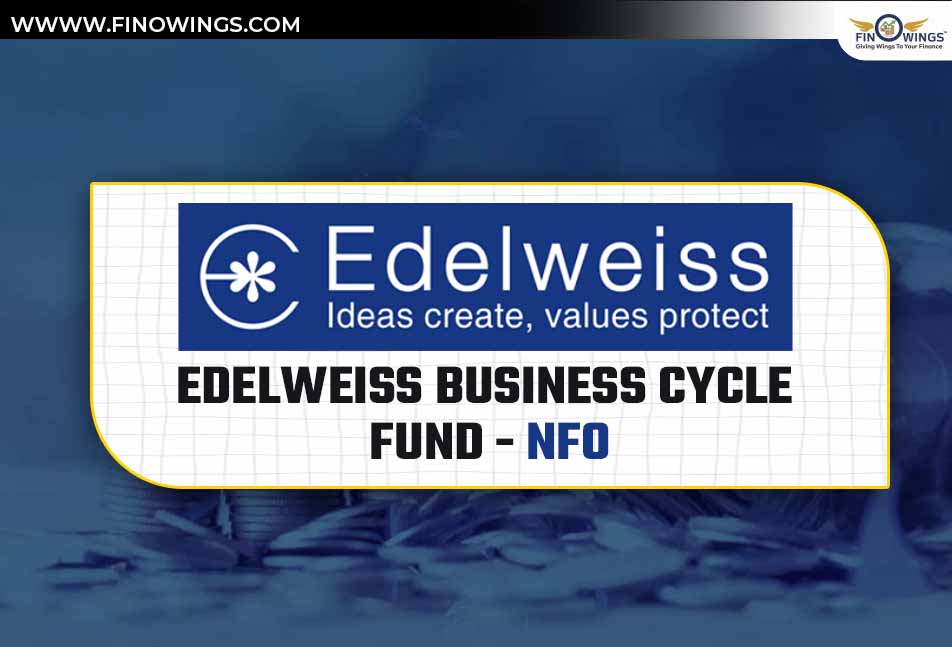Home >> Blog >> Edelweiss Business Cycle Fund NFO: Review, Date & NAV
Edelweiss Business Cycle Fund NFO: Review, Date & NAV

Table of Contents
- Introduction
- Everything You Need To Know About Edelweiss Business Cycle Fund NFO
- Edelweiss Business Cycle Fund - NFO Overview
- Fund Overview
- How To Invest In The NFO After The Closure Date?
- The Objective Of The Fund
- Peers Of Edelweiss Business Cycle Fund
- Risk Factors In This Scheme
- Past Performance Of Business Cycle Funds
- Edelweiss Business Cycle Fund NFO - Who Can Invest?
- Edelweiss Business Cycle Fund NFO - Growth Fund Managers
- Conclusion
Introduction
If you’re already a key player or new to the world of NFOs, you've come to the correct spot to learn about the latest trends, insights, and news influencing this dynamic market. We are today at Edelweiss Business Cycle Fund-NFO Blog committed to giving you insightful knowledge, Financial attributes, past performance if any, etc. on this NFO.
Everything You Need To Know About Edelweiss Business Cycle Fund NFO
The Edelweiss Business Cycle Fund NFO by Edelweiss Asset Management Limited under the house Edelweiss Mutual Fund has introduced the Edelweiss Business Cycle Fund Direct-Growth, which is an open-ended Equity plan with an investment strategy centered on business cycles. The lowest investment required to join is Rs.5000 for investors and in multiple of Rs.1 thereof. The Scheme’s investments will mostly be made in any of the following:
-
Equity and instruments associated with Equity.
-
Securities in the debt and money markets.
-
Instruments derivatives.
-
Option Covered Calls.
-
Real Estate Investment Trust (REIT) and Infrastructure Investment Trust (InvIT) units.
-
Mutual Fund Schemes.
-
Foreign ETFs and foreign securities.
The Scheme has a 1% Exit Load if redeemed on or before 90 days.
To learn about the Fund's asset allocation, and other financial characteristics that influence decision-making, carefully read this blog.
Edelweiss Business Cycle Fund - NFO Overview
The investment period for the Scheme is set for July 09, 2024, to July 23, 2024. The Scheme is a very high-risk Scheme. There is no assurance that the Scheme's investment goal will be met. The Scheme will allocate 80–100% of its investment capital to investing in Equity and Equity-related derivatives based on the business cycle including Equity ETFs and the remaining portion will be allocated to Other Equity & Equity related instruments (0 to 20%), Debt including Debt ETFs (0 to 20%), money market instruments (0 to 20%), and Units issued by REITs and InvITs (0 to 10%). Since this Scheme is new hence no past performance record is available.
Fund Overview
|
Start Date |
09 July 2024 |
|
End Date |
23 July 2024 |
|
Allotment Date / Subscription Date |
Not more than 5 Business days after the closure date of the NFO. |
|
VRO Rating |
- |
|
Expense Ratio |
NA |
|
Exit Load |
1% Exit Load if redeemed within 90 days. |
|
Fund Size |
NA |
|
Lock-In |
NA |
|
Stamp Duty |
0.005% (From July 1st 2020) |
|
Benchmark |
Nifty 500 TRI |
|
Min. Investment |
Rs.5000 and in multiples of Rs.1 |
|
Risk |
Very High |
|
Short-Term Capital Gains (STCG) |
Returns taxed at 15% if you redeem before 1 year |
|
Long-Term Capital Gains (LTCG) |
After 1 year, pay a LTCG tax of 10% on returns of Rs.1 lakh+ in a financial year |
How To Invest In The NFO After The Closure Date?
If you have missed participating in the NFO and now want to invest in the same Scheme on a continuous basis, then generally after 5 business days after the closure date of the NFO; you will have the option to participate and invest directly with the Mutual by spending minimum 100 Rs. and in multiple of Rs.1 thereafter by logging on to your demat account and search for “Edelweiss Business Cycle Fund- NFO” on Nifty 500 TRI.
To open your Demat account, Click Here.
The Objective Of The Fund
The Scheme intends to create long-term capital appreciation by investing primarily in Equities and Equity-related instruments and strategically allocating assets across different sectors and stocks at different points in the economy's business cycle. Nevertheless, there can be no promise or guarantee that the Scheme's investment goal will be met.
Asset allocation (% of Net Assets) Of The Scheme's Portfolio Will Be As Follows:
|
Types of Instruments |
Min Allocation (% of Net Assets) |
Max Allocation (% of Net Assets) |
|
Equity and Equity-related derivatives based on the business cycle including Equity ETFs |
80 |
100 |
|
Other Equity & Equity related instruments |
0 |
20 |
|
Debt including Debt ETFs money market instruments |
0 |
20 |
|
Units issued by REITs and InvITs |
0 |
10 |
Peers Of Edelweiss Business Cycle Fund
|
Multi Cap Funds |
1Y Return |
AUM (Cr) |
|
Invesco India PSU Equity Fund Direct-Growth |
100.5% |
1363 |
|
Aditya Birla Sun Life PSU Equity Fund Direct-Growth |
94.3% |
5122 |
|
Nippon India Power & Infra Fund Direct-Growth |
83.9% |
6694 |
|
ICICI Prudential Business Cycle Fund Direct-Growth |
49.8% |
10907 |
Risk Factors In This Scheme
-
At least 80% of the Scheme's net assets shall be allocated to Equity and Equity-related securities of businesses chosen based on their business cycles. Because the Scheme is themed, the risks related to the theme or sector will have an impact.
-
A fixed-income instrument's price typically decreases as interest rates rise and vice versa. The coupon and maturity of the security determine how much the prices will drop or rise. Additionally, it is based on the rate of return at which the security is exchanged. A decrease in interest rates is predicted to boost the Scheme's NAV, whilst an increase in interest rates would have the opposite effect.
-
Changes in the dynamics affecting the debt market, in particular, could have an effect on the Scheme's performance.
-
Reinvestment risk could arise if monthly cashflows to the Scheme are received earlier than anticipated.
-
Lower-rated or unrated securities are more likely to react to developments affecting the market as they tend to be more sensitive to changes in economic conditions than higher-rated securities.
Past Performance Of Business Cycle Funds
|
Multi Cap Funds |
NAV (Rs.) |
Annualized Return (1Y) |
Return/Risk |
|
ICICI Prudential Business Cycle Fund |
23.91 |
48.79% |
Very High Risk |
|
Quant Business Cycle Fund Regular Growth |
17.91 |
71.01% |
Very High Risk |
|
HDFC Business Cycle Fund Direct-Growth |
14.72 |
33.09% |
Very High Risk |
|
Tata Business Cycle Fund Regular - Growth |
19.45 |
50.90% |
Very High Risk |
Edelweiss Business Cycle Fund NFO - Who Can Invest?
This Fund is ideal for you if you are looking for long-term wealth generation and invest in stocks and Equity-related securities with an emphasis on managing business cycles by dynamically allocating Funds across different industries and Equities during different phases of the economy's business cycles.
Edelweiss Business Cycle Fund NFO - Growth Fund Managers
-
Mr. Bhavesh Jain
-
Mr. Bharat Lahoti
-
Mr. Amit Vora
Conclusion
The Scheme comes under a very high-risk category and has no previous performance track record. It plans to invest in Equities and Equity-related instruments and strategically allocate assets across different sectors and stocks at different points in the economy's business cycle. There is no guarantee that the goals of this Scheme will be achieved. Research well according to your objectives, and the time horizon of your investment.
Disclaimer: This NFO analysis is provided solely for informative reasons and should not be construed as investment advice. Always conduct research and talk with a financial advisor before investing.
Frequently Asked Questions
The launching date of this NFO is July 09, 2024.
The end date of this NFO is 23 July 2024.
The NFO's Fund Managers are Mr. Bhavesh Jain, Mr. Bharat Lahoti, and Mr. Amit Vora.
The minimum investment for the NFO is Rs.5000 and in multiples of Rs.1.
Yes, you can apply and invest in this Scheme on a continuous basis not more than 5 working days after the closure date of the NFO with a minimum amount of Rs.100 and in multiples of Rs.1 thereafter by logging on to your Demat account and search for “Edelweiss Business Cycle Fund- NFO” on Nifty 500 TRI.













